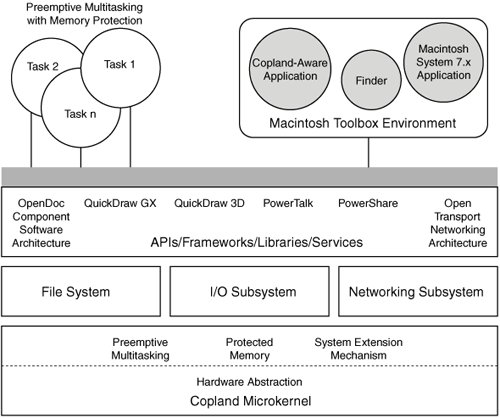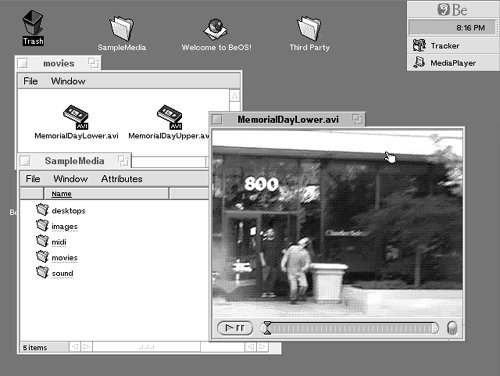Section 1.1. Apple s Quest for the Operating System
1.1. Apple's Quest for the[2] Operating System
It was March 1988. The Macintosh had been around for four years. Some Apple engineers and managers had an offsite meeting. As they brainstormed to come up with future operating system strategies, they noted down their ideas on three sets of index cards that were colored blue, pink, and red. Blue would be the project for improving the existing Macintosh operating system. It would eventually form the core of System 7. Pink would soon become a revolutionary operating system project at Apple. The operating system was planned to be object-oriented. It would have full memory protection, multitasking with lightweight threads, a large number of protected address spaces, and several other modern features. After languishing for many years at Apple, Pink would move out to Taligent, a company jointly run by Apple and IBM. Since the color red is "pinker than pink," ideas considered too advanced even for Pink were made part of the Red project. As the 1980s drew to an end, the Macintosh system software was at major version 6. System 7, a result of the Blue project, would be Apple's most significant system yet. However, that would not appear until 1991. Meanwhile, Microsoft had developed its Windows 3.x operating system, which became extremely successful after its release in 1990. Microsoft had also been working on a new operating system codenamed Chicago. Initially slated for release in 1993, Chicago kept slipping. It was eventually released as Windows 95. However, Microsoft did release another Windows operating systemWindows NTin 1993 (Figure 11). NT was an advanced operating system meant for high-end client-server applications. It had various important features such as symmetric multiprocessing support, a preemptive scheduler, integrated networking, subsystems for OS/2 and POSIX, virtual machines for DOS and 16-bit Windows, a new file system called NTFS, and support for the Win32 API. Figure 11. Microsoft Windows NT 3.1 Apple needed an answer to Microsoft's onslaught, particularly in the face of the upcoming Windows 95, which was to be an end-user operating system. The Pink and Red projects would turn out to be rather unsuccessful. Apple would continue to attempt to solve the "OS problem" one way or another. 1.1.1. Star TrekStar Trek was a bold project that Apple ran jointly with Novell to port Mac OS to run on the x86 platform. A team consisting of engineers from both Apple and Novell succeeded in creating a very reasonable prototype in an incredibly short amount of time. The project was canceled, however, for various reasons: Apple had already committed to the PowerPC; many within and outside of Apple thought that adding support for the x86 platform would disrupt Apple's existing business model; and vendor feedback was not encouraging. Many years later, Darwinthe core of Apple's far more successful Mac OS Xruns on both the PowerPC and the x86. Whereas the Star Trek prototype showed the "Happy Mac" logo while booting up, Darwin/x86 prints the message "Welcome to Macintosh" during boot. Star Trek was finally vindicated with Apple's mid-2005 announcement of transitioning Mac OS X to the x86 platform. The first x86-based Macintosh computersthe iMac and the MacBook Pro (the successor to the PowerBook)were unveiled at the San Francisco Macworld Conference & Expo in January 2006. 1.1.2. RaptorRaptor was, in many respects, the Red project. It was supposed to provide Apple with a next-generation microkernel that would run on any architecture. As the Star Trek project was being canceled, it was considered for absorption by Raptor, which itself died later due to budgetary limitations and employee attrition, among other reasons. 1.1.3. NuKernelNuKernel was a kernel project at Apple that was meant to result in a modern operating system kernel on more than one occasion. NuKernel was meant to be an efficient microkernel that would facilitate features such as preemptive multitasking, protected memory, an efficient memory model, a high degree of system extensibility, and most significantly, a hardware abstraction layer (HAL) that was expected to allow any computer vendor to easily design Mac OScompatible systems. 1.1.4. TalOSApple and IBM formed a company called Taligent in early 1992 to continue work on the Pink project. Pink originally aimed to be an object-oriented operating system but later morphed into an object-oriented environment called CommonPoint that ran on many modern operating systems such as AIX, HP-UX, OS/2, Windows 95, and Windows NT. It was also meant to run on Apple's NuKernel. Taligent Object Services (TalOS) was the name given to a set of lower-level technologies to be built around version 3.0 of the Mach kernel. TalOS was meant to be an extensible and portable operating system, with a small footprint and good performance. TalOS was object-oriented from the kernel up, with even device drivers and network protocols implemented in an object-oriented fashion. Taligent's object-oriented libraries were known as frameworks. There were frameworks for user interfaces, text, documents, graphics, multimedia, fonts, printing, and low-level services such as drivers. These, along with the TalOS development tools, explicitly strived to shift the burden of programming from application developers to application system engineers. Note that even though there existed other commercial systems such as NEXTSTEP that had object-oriented application frameworks, Taligent aimed to build its entire programming model around objects. In NEXTSTEP, the developers who created frameworks had to map object behavior to the underlying libraries, Unix system calls, Display PostScript, and so onall of which had procedural APIs. In contrast, Taligent's CommonPoint applications were not meant to use the host operating system APIs at all. In 1995, Taligent became a wholly owned subsidiary of IBM. The Pink project did not give Apple the next-generation operating system that Apple had been seeking. 1.1.5. CoplandApple made an announcement in early 1994 that it would channel more than a decade of experience into the next major release of the Macintosh operating system: Mac OS 8. The project was codenamed Copland. It was expected that Copland would be Apple's real response to Microsoft Windows. With Copland, Apple hoped to achieve several goals, many of which had been long elusive.
To achieve these goals, Copland was supposed to have a comprehensive set of system-level features, for example:
Figure 12 shows a conceptual view of Copland. Figure 12. Copland architecture Work on Copland gained momentum during the early 1990s, and by the mid-1990s, Copland was heavily counted on to do wonders for the company. Apple dubbed it as "The Mac OS Foundation for the Next Generation of Personal Computers." However, the project kept slipping. A few prototypical Driver Development Kit (DDK) releases went out, but a 1996 releaseas had been planned and hoped fordid not seem feasible. Due to numerous pressures, full memory protection had not been included after all. Apple's CEO Gil Amelio described the state of Copland as "just a collection of separate pieces, each being worked on by a different team . . . that were expected to magically come together somehow. . . ."[4]
Apple eventually decided to cancel Copland in May 1996. Amelio announced that Copland's best pieces would be shipped with future releases of their existing system, beginning with the upcoming System 7.6, whose name was formally changed to Mac OS 7.6. 1.1.6. GershwinAfter the Copland debacle, Apple's need for a new operating system was direr than ever. Focus shifted briefly to a project named Gershwin, which was to include the painfully elusive memory protection, among other things. However, it was apparently nothing more than a codename, and it is believed that nobody ever worked on Gershwin. 1.1.7. BeOSApple briefly considered partnering with Microsoft to create an Apple OS based on Windows NT. Other systems under consideration were Solaris from Sun Microsystems and BeOS from Be. In fact, Apple's acquisition of Be came rather close to materializing. Be was founded in 1990 by Jean-Louis Gassée, Apple's former head of product development. Be's capable engineering team had created an impressive operating system in BeOS (Figure 13). It had memory protection, preemptive multitasking, and symmetric multiprocessing. It even ran on the PowerPC,[5] thus fitting with Apple's hardware agenda. BeOS was designed to be especially adept at handling multimedia. It had a metadata-rich file system called BeFS that allowed files to be accessed via multiple attributes. However, BeOS was still an unfinished and unproven product. For example, it did not yet support file sharing or printing, and only a few applications had been written for it.
Figure 13. BeOS Gassée and Apple negotiated back and forth over Be's acquisition. The total investment in Be at that time was estimated at about $20 million, and Apple valued Be at $50 million. Gassée sought over $500 million, confident that Apple would buy Be. Apple negotiated up to $125 million, and Be negotiated down to $300 million. When things still did not work out, Apple offered $200 million, and even though it is rumored that Gassée was actually willing to accept this offer, it is also said that he came back with a "final price" of $275 million, hoping Apple would bite the bullet. The deal did not happen. In any case, Be had a tough contender in NeXT, a company founded and run by another one-time Apple employee: Steve Jobs. Be eventually failed as a companyits technological assets were acquired by Palm, Inc., in 2001. 1.1.8. Plan AUnlike Be, NeXT's operating systems had at least been proven in the market, despite NeXT not having any resounding successes. In particular, the OPENSTEP system had been well received in the enterprise market. Moreover, Steve Jobs pitched NeXT's technology very strongly to Apple, asserting that OPENSTEP was many years ahead of the market. The deal with NeXT did go through: Apple acquired NeXT in February 1997 for over $400 million. Amelio later quipped that they picked "plan A" instead of "plan Be."[6]
NeXT's acquisition would prove pivotal to Apple, as NeXT's operating system technology would be the basis for what would become Mac OS X. Let us now look at the background of NeXT's systems. |
EAN: 2147483647
Pages: 161